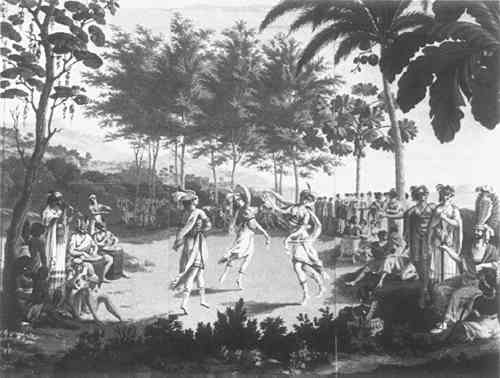CONSERVATION OF SCENIC WALLPAPERS: SAUVAGES DE LA MER DU PACIFIQUERobert Futernick
5 PREPARATION FOR INSTALLATIONDISPLAY MOUNTS for the panels were first constructed of a resin-sealed wooden lattice structure that was then covered on both sides with acid-free cardboard and paper. They were made to accommodate the height of the taller panels. Paper toned to match the sky had been added to the shorter rolls, bringing them to the proper measurement. The width of the mount was made to match the dimension relating to the design area of the wallpapers. In this way, the unprinted margin could be preserved by turning it onto the edge of the display mount. The panels could then be placed in close contact to achieve proper alignment of the images. Problems developed, however, because the width measurement for each panel varied. Creasing and folding all of the papers to a standard dimension meant that part of the image on many sections would be lost. To compensate, each mount was shimmed to the appropriate width by adding the necessary thickness of paper or rag board to the edge. The last phase of treatment, attachment of the wallpaper to the display mounts, was undertaken. The plan was to stretch the lined papers across the mounts much the way a canvas is prepared for oil painting. Pins were to be temporarily placed through the extending lining into the edge of the mount. The entire panel would then be turned face down and the protruding lining stapled to the reverse. Two sections were mounted in this way and all seemed fine until the next day when We still had the question of what to do about the two missing sections, numbers 8 and 16. Mounts were constructed, and a well known scenic artist, Garth Benton, was employed. With the aid of color transparencies he reproduced the missing panels to near perfection. Viewed along-side the originals, the fascimiles are difficult to detect. One final dilemma remained. The original exhibition scheme included placement of the Dufour paper on the walls of the recently acquired Newburyport room. To proceed with this plan would be to face the same problem that has arisen for as long as scenic wallpapers have been printed in standard sizes and later installed in rooms of differing dimensions. Contemporary papers pose little problem. They can be trimmed to match room specifications as necessary. Dufour wallpapers, however, have emerged as rare and important historic objects, indicated in part by the great care given them in conservation. The idea of trimming even the unprinted margins, much less the extensive sky region, was out of the question. At one point, consideration was given to elevating the ceiling, but this also was unacceptable if the parlor's
ACKNOWLEDGEMENTSTHE SUCCESS of this project would not have been possible without the inspired help of an entire group of conservators and technicians. Interaction of paper and painting conservators yielded a treatment result that was far superior than could be achieved without that cooperation. Those most directly responsible were James Bernstein, Niccolo Caldararo, Debbie Fox, Leslie Kruth, Mary Wood Lee, Pauline Mohr, Brenda Palley, Mark Tucker, and Melinda Tucker. |
